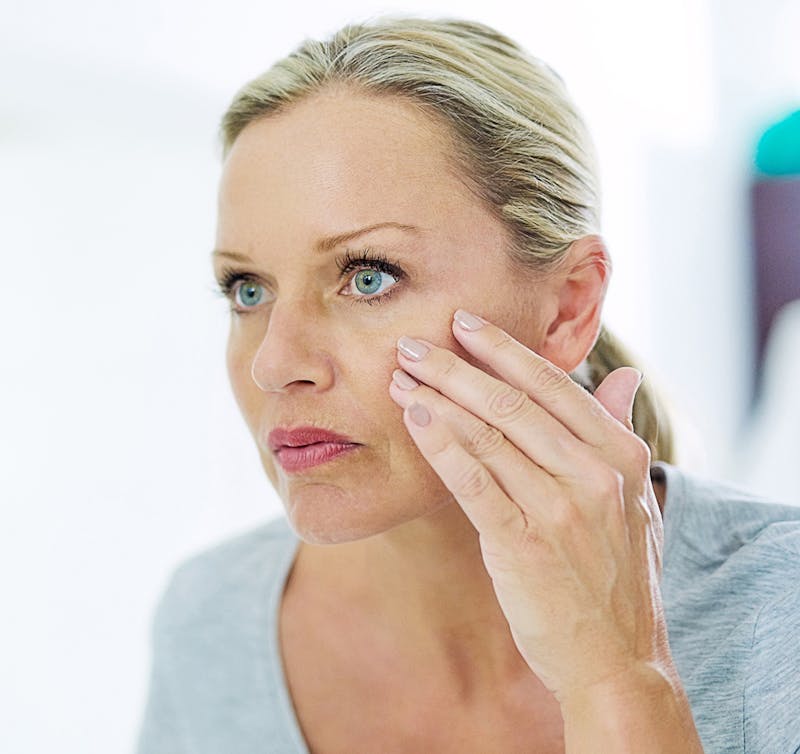
At Kelly Vision, our board-certified ophthalmologists, Dr. Ashley Brissette and Dr. James Kelly, leverage decades of experience diagnosing and treating dry eye disease in NYC. They have authored peer-reviewed research and trained fellow physicians on the latest advances in ocular surface care. Our state-of-the-art dry eye treatment center enables us to provide personalized, evidence-based solutions for complex cases.
This precision is particularly crucial for diagnosing dry eye in women during and after menopause, as hormonal shifts can affect tear film stability and lead to conditions like Sjögren’s disease. Accurate diagnosis is vital to determine the appropriate treatment and ensure long-term eye health.
Why Dry Eye is So Common Around Menopause
Women are disproportionately affected by dry eye disease, and research shows that sex hormones are a key factor.
According to the TFOS DEWS II Sex, Gender & Hormones Report:
- Androgens help maintain healthy oil production from the meibomian glands
- Fluctuations in estrogen and other hormones can trigger inflammation and destabilize the tear film
- These biological changes explain why many women notice worsening symptoms during the menopausal transition
Hormone therapy has also been studied for its impact on eye health. According to extensive Women’s Health Study data, summarized in the American Academy of Ophthalmology’s Preferred Practice Pattern, post-menopausal hormone therapy can influence dry eye risk. For example:
- Estrogen therapy alone is associated with a higher risk of clinically diagnosed dry eye
- Estrogen plus progesterone is associated with elevated risk as well, though to a lesser degree
To sum it up, menopause-related hormone changes can:
- Reduce the quality of meibum (the oily layer of the tear film)
- Heighten inflammation on the ocular surface
- Increase the likelihood of evaporative dry eye
Autoimmune Disorders and Dry Eye: A Different Mechanism
Autoimmune conditions can worsen dry eye by damaging the tear-producing lacrimal glands, leading to a severe form of aqueous-deficient dry eye. A typical example is Sjögren’s disease, where the immune system attacks moisture-producing glands, causing dry eyes and mouth. According to the NIH's NIAMS, these "sicca" symptoms may also affect other organs.
Here’s what you need to know:
- Clinical importance of Sjögren’s dry eye (SS-DED): The American Academy of Ophthalmology emphasizes that early recognition is essential to prevent ocular and systemic complications, and has outlined specific diagnostic and management guidelines (AAO EyeNet)
- Treatment guidance: The Sjögren’s Foundation Clinical Practice Guidelines highlight distinguishing between aqueous-deficient and evaporative mechanisms to design effective therapy (Sjögren’s Ocular CPG)
Autoimmune conditions like rheumatoid arthritis and lupus can cause inflammation in ocular tissues, leading to dry eye symptoms. In autoimmune-driven dry eye, the primary problem is often tear underproduction, not just evaporation. Therefore, treatment should address lacrimal gland dysfunction and inflammation, not just surface lubrication.
How We Pinpoint Your Dry Eye Type (And Why It Matters)
Kelly Vision combines a thorough intake process with advanced diagnostics to identify the dominant mechanisms. Since menopausal and autoimmune dry eye have different underlying causes, treatment plans are customized accordingly.
For evaporative/MGD-predominant (common in menopause):
- Intense Pulsed Light (OptiLIGHT™ IPL) to reduce peri-lid inflammation and improve meibomian flow (evidence-based anti-inflammatory approach consistent with AAO PPP treatment tiers)
- OptiLIFT™ radiofrequency for heat-based gland support and eyelid tightening
- LipiFlow® thermal pulsation to liquefy and evacuate obstructed glands
- Lid hygiene/blepharoexfoliation and blink training; targeted anti-inflammatory drops when indicated
For aqueous-deficient (common in autoimmune disease):
- Prescription immunomodulatory drops to quell surface inflammation
- Punctal occlusion (plugs or LacriFill gel) to conserve tears
- Autologous serum eye drops and amniotic membrane therapies for severe surface disease, approaches supported in specialty care pathways and guidelines
We’ll also coordinate with your rheumatologist or gynecologist when systemic therapy impacts ocular surface health, an integrated approach recommended by specialty guidelines.
Ready to Feel Better?
You’re never a number here at Kelly Vision NYC. Our board-certified surgeons and dry eye specialists use leading diagnostics and a full toolkit to restore comfort and protect long-term ocular health. We’ll personalize your plan, collaborate with your other physicians as needed, and track measurable improvement over time.
Clear, comfortable vision is within reach. Contact us today to schedule a consultation with our dry eyes specialist in NYC, (Manhattan) or Long Island.


